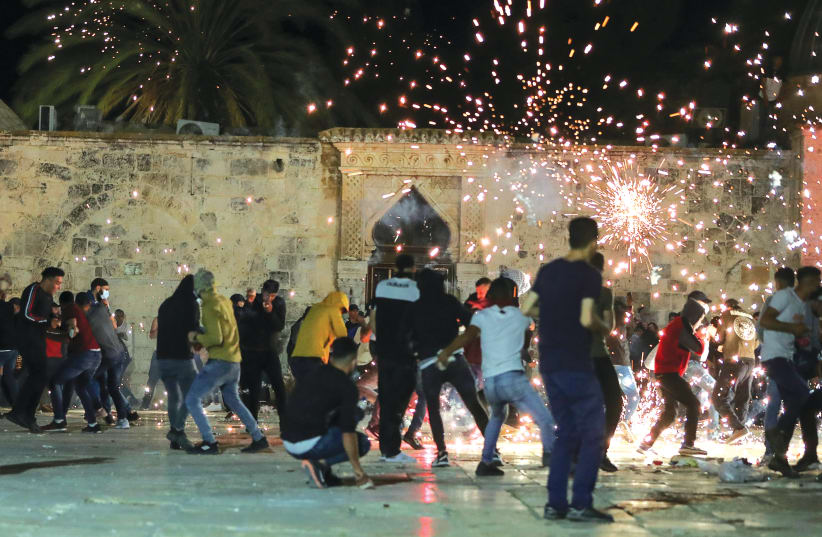There’s one problem with that: It’s wrong. But this is certainly not the first time that the “single point of failure” narrative has been wielded to explain a campaign of organized Palestinian or Arab-Israeli violence.
First, let’s unpack the current conflict. Signs of tension were clear long before the eviction. There was a viral TikTok craze in April of Arab youths beating up Jews. Arab-Israelis and Gazans were also “hangry” from their fasts during Ramadan, a perennial time of tension in the region. Palestinian frustrations were boiling over, after the cancellation of their first parliamentary elections in 15 years. Hamas, in particular, sought to assert its primacy after being sidelined in the wake of the canceled elections. And more broadly, Palestinian leaders increasingly felt that their cause was losing international interest.
The Sheikh Jarrah narrative ignores all of this. It also ignores that Hamas just happened to have thousands of rockets prepared for launch, not to mention a tunnel system prepared for commando attacks against Israeli soldiers.
But the single point of failure (or friction) theory is wildly popular. And it’s a trap that reporters fall into often. A somewhat recent example is the outbreak of the Second Intifada in 2000. Opposition leader Ariel Sharon’s visit to the Temple Mount was the purported catalyst. The former general walked with a security entourage on the Temple Mount on September 28, 2000, in what was widely deemed a provocative act. Palestinians responded with protests.
But did Sharon single-handedly provoke a five-year conflict? According to senior Hamas officials and Palestinian president Yasser Arafat’s widow, the Palestinian leader had already decided to launch an intifada when he walked away from US-led negotiations with Israel at Camp David in July 2000. The planned unrest may have been intended to be smaller in scope, but it was prearranged to gain the Palestinians leverage at the negotiating table. Sharon’s stroll was not the cause. Rather, the unrest was the coordinated decision of the Palestinian leadership.
The 1929 riots, one of the first serious bouts of Arab violence against Jews in the Holy Land, is another campaign of violence falsely blamed on a single provocation. On August 15, 1929, after Jews asserted their right to pray at the Western Wall, Arab leaders warned that Jews planned overtake al-Aqsa Mosque. Nine days later, Arab mobs butchered nearly 70 Jews in the city of Hebron. More massacres followed. The event, even today, is blamed on Jews crossing a religious redline. But the cause of the violence was a coordinated decision of the Palestinian leadership.
Palestinian leadership pushed the single point of failure narrative when it acceded to the International Criminal Court. The Palestinians accepted ICC jurisdiction over the West Bank and Gaza starting on June 13, 2014, which marked the start of Israeli raids on Hamas and other Palestinian terrorists in the West Bank. This narrative, focusing on the specific operations of the IDF, conveniently excludes the kidnapping and killing of three Israeli teens on June 12 – one event among several that ultimately gave way to the third Israel-Hamas mini-war.
The Palestinian reliance on singular events to build a narrative has been mimicked by Hezbollah, too. When Israel ended its military presence in southern Lebanon in May 2000, it held on to a disputed territory known as Mount Dov (aka Shaba Farms). Israel had previously seized it from Syria in the 1967 Six Day War. Despite this history, and despite Israel’s withdrawal from the rest of south Lebanon, Hezbollah pointed to Israel’s decision as a grave provocation. For years subsequently, the group wielded it as justification for its military campaign against Israel. It was a campaign that it was dedicated to fighting, with Iranian backing, no matter what territory Israel held. Yet, Shaba Farms was a rallying cry for Hezbollah – and one parroted by many reporters who tracked this conflict.
THERE IS one particularly notable exception to this single point of failure/friction canard: the First Intifada. History shows that this uprising was indeed a spontaneous expression of Palestinian discontent. On December 8, 1987, an Israeli truck crashed into a group of Palestinian cars at the Erez crossing at the Israel-Gaza border, killing four. The victims’ funerals attracted thousands and led to massive protests, which soon spawned a more coordinated effort. What followed was a campaign of violence that marked the emergence of a new terrorist group: Hamas.
Hamas has for decades since tried to capture and recreate that sense of spontaneous frustration that led to the first intifada. So have its allies in the Iran-backed “Axis of Resistance.” They have not been able to do so. But not for a lack of trying.
In the Middle East, nothing happens in a vacuum. Sometimes tensions run high. Sometimes a false sense of calm prevails. But the flame is always burning low, susceptible to anything combustible. The preparations for conflict are a constant. There is no single point of failure. Except, perhaps, in the reporting that follows.
Jonathan Schanzer is senior vice president for research at Foundation for Defense of Democracies, where David May is a research analyst.
